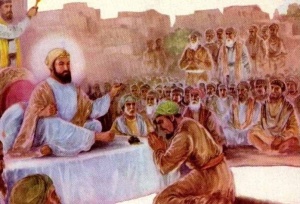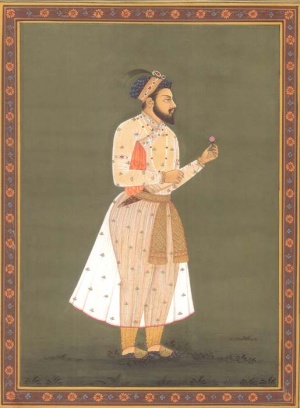Dara Shikoh: Difference between revisions
Hari singh (talk | contribs) mNo edit summary |
|||
| Line 1: | Line 1: | ||
[[Image:Portrait_of_dara_shikoh_mf69.jpg|thumb|right|300px|Potrait | [[Image:Portrait_of_dara_shikoh_mf69.jpg|thumb|right|300px|{{C|Potrait of Dara Shikoh}}]] | ||
'''Dara Shikoh''' (1615–1659) was the eldest son of the [[Mughal]] Emperor [[Shah Jahan]] and his wife Mumtaz Mahal. His name is from Persian and means "The possessor of Glory". He was favored as a successor by his father and his sister Jahanara Begum, but was defeated and beheaded by his younger brother [[Aurangzeb]] in a bitter struggle for the Mughal throne. | '''Dara Shikoh''' (1615–1659) was the eldest son of the [[Mughal]] Emperor [[Shah Jahan]] and his wife Mumtaz Mahal. His name is from Persian and means "The possessor of Glory". He was favored as a successor by his father and his sister Jahanara Begum, but was defeated and beheaded by his younger brother [[Aurangzeb]] in a bitter struggle for the Mughal throne. | ||
==Dara Shikoh | ==Dara Shikoh and Guru Har Rai== | ||
{{main|Guru Har Rai Sahib Cures Dara Shikoh}} | {{main|Guru Har Rai Sahib Cures Dara Shikoh}} | ||
Dara Shikoh was near death having been feed some hair clipped from a Lion , which had been added to some of his food on the orders of his brother Aurangzeb. [[Guru Har Rai]] ji sent some hard to find ayurvedic medicine to help in his cure, which included a Yang of 5 Tola and laung of 3 masha (Ath Ratti bhar Tol). | Dara Shikoh was near death having been feed some hair clipped from a Lion , which had been added to some of his food on the orders of his brother [[Aurangzeb]]. [[Guru Har Rai]] ji sent some hard to find ayurvedic medicine to help in his cure, which included a Yang of 5 Tola and laung of 3 masha (Ath Ratti bhar Tol). | ||
So from this history, it is also said that Guru Har Rai jee was a Good Doctor too. Dara Shikoh in return gifted a Silver Kaathi of horse with dushaley and horse too. | So from this history, it is also said that Guru Har Rai jee was a Good Doctor too. Dara Shikoh in return gifted a Silver Kaathi of horse with dushaley and horse too. | ||
| Line 13: | Line 13: | ||
Dara Shikoh was a gentle and pious Sufi intellectual. He favored religious tolerance, and coexistence between [[Hindus]] and [[Muslims]]. Many historians have speculated how different India would have been had he prevailed over his fierce fundamentalist brother Aurangzeb. | Dara Shikoh was a gentle and pious Sufi intellectual. He favored religious tolerance, and coexistence between [[Hindus]] and [[Muslims]]. Many historians have speculated how different India would have been had he prevailed over his fierce fundamentalist brother Aurangzeb. | ||
[[Image:Darashikoh.jpg|thumb|right|300px|Dara Shikoh | [[Image:Darashikoh.jpg|thumb|right|300px|{{c|Dara Shikoh and [[Guru Har Rai]]}} ]] | ||
Dara Shikoh was a follower of [[Lahore|Lahore's]] famous Qadiri Sufi [[Saint Mian Mir]], whom he was introduced to by Mullah Shah Badakhshi (Mian Mir's spiritual disciple and successor). Shikoh devoted much effort towards finding a common mystical language between [[Islam]] and [[Hinduism]]. Towards this goal he translated the Upanishads from its original [[Sanskrit]] into [[Persian]] so it could be read by Muslim scholars. His translation is often called "Sirre Akbar" or The Greatest Mystery while in Arabic, the Upanishads are referred to as "Kitab al-maknun" or the hidden book. His most famous work, Majma ul-Bahrain ("The Mingling of the Two Oceans") was also devoted to finding the commonalities between [[Sufism]] and Hindu Monotheism. He was also a patron of fine arts, music and dancing, a trait frowned upon by his sibling Aurangzeb. In fact many of his paintings are quite detailed and compare well to a professional artist of his time. The Dara Shikoh album is a collection of paintings and calligraphy assembled during the 1630s until his death. It was presented to his wife Nadira Banu and remained with her until her death after which the album was taken into the royal library and the inscriptions connecting it with Dara Shikoh were deliberately, erased; however not everything was vandalised and many calligraphy scripts and paintings still bear his mark. | Dara Shikoh was a follower of [[Lahore|Lahore's]] famous Qadiri Sufi [[Saint Mian Mir]], whom he was introduced to by Mullah Shah Badakhshi (Mian Mir's spiritual disciple and successor). Shikoh devoted much effort towards finding a common mystical language between [[Islam]] and [[Hinduism]]. Towards this goal he translated the Upanishads from its original [[Sanskrit]] into [[Persian]] so it could be read by Muslim scholars. His translation is often called "Sirre Akbar" or The Greatest Mystery while in Arabic, the Upanishads are referred to as "Kitab al-maknun" or the hidden book. His most famous work, Majma ul-Bahrain ("The Mingling of the Two Oceans") was also devoted to finding the commonalities between [[Sufism]] and Hindu Monotheism. He was also a patron of fine arts, music and dancing, a trait frowned upon by his sibling Aurangzeb. In fact many of his paintings are quite detailed and compare well to a professional artist of his time. The Dara Shikoh album is a collection of paintings and calligraphy assembled during the 1630s until his death. It was presented to his wife Nadira Banu and remained with her until her death after which the album was taken into the royal library and the inscriptions connecting it with Dara Shikoh were deliberately, erased; however not everything was vandalised and many calligraphy scripts and paintings still bear his mark. | ||
Revision as of 10:48, 14 July 2008
Dara Shikoh (1615–1659) was the eldest son of the Mughal Emperor Shah Jahan and his wife Mumtaz Mahal. His name is from Persian and means "The possessor of Glory". He was favored as a successor by his father and his sister Jahanara Begum, but was defeated and beheaded by his younger brother Aurangzeb in a bitter struggle for the Mughal throne.
Dara Shikoh and Guru Har Rai
- Main article: Guru Har Rai Sahib Cures Dara Shikoh
Dara Shikoh was near death having been feed some hair clipped from a Lion , which had been added to some of his food on the orders of his brother Aurangzeb. Guru Har Rai ji sent some hard to find ayurvedic medicine to help in his cure, which included a Yang of 5 Tola and laung of 3 masha (Ath Ratti bhar Tol).
So from this history, it is also said that Guru Har Rai jee was a Good Doctor too. Dara Shikoh in return gifted a Silver Kaathi of horse with dushaley and horse too.
More About Him
In 1657, the illness of emperor Shah Jahan triggered a fierce and desperate battle for power among the four Mughal princes -Dara Shikoh, Shuja Muhammad, Aurangzeb, and Murad Baksh though realistically only Dara and Aurangzeb had a chance to emerge victorious. Shah Shuja declared himself emperor in Bengal. Despite strong support from Shah Jahan, who had recovered enough from his illness to remain a strong factor in the struggle for supremacy, and victories over Shah Shuja, Dara was defeated by Aurangzeb at the battlefield of Samogarh, 13 km from Agra on 8 June 1658. He attempted to rally support after this defeat, and sought refuge under Malik Jiwan, a Baluch chieftain, who had once been saved by the Moghul prince from the wrath of Shah Jehan. However, Malik betrayed Dara and and turned him over to his brother Aurangzeb. Marched through the streets of the capital in chains, he was at first held prisoner, and then cruelly killed by men seeking the favor of his brother. It is said that Aurangzeb beheaded the corpse of Dara Shikoh and had his severed head taken to their father.
Dara Shikoh was a gentle and pious Sufi intellectual. He favored religious tolerance, and coexistence between Hindus and Muslims. Many historians have speculated how different India would have been had he prevailed over his fierce fundamentalist brother Aurangzeb.

Dara Shikoh was a follower of Lahore's famous Qadiri Sufi Saint Mian Mir, whom he was introduced to by Mullah Shah Badakhshi (Mian Mir's spiritual disciple and successor). Shikoh devoted much effort towards finding a common mystical language between Islam and Hinduism. Towards this goal he translated the Upanishads from its original Sanskrit into Persian so it could be read by Muslim scholars. His translation is often called "Sirre Akbar" or The Greatest Mystery while in Arabic, the Upanishads are referred to as "Kitab al-maknun" or the hidden book. His most famous work, Majma ul-Bahrain ("The Mingling of the Two Oceans") was also devoted to finding the commonalities between Sufism and Hindu Monotheism. He was also a patron of fine arts, music and dancing, a trait frowned upon by his sibling Aurangzeb. In fact many of his paintings are quite detailed and compare well to a professional artist of his time. The Dara Shikoh album is a collection of paintings and calligraphy assembled during the 1630s until his death. It was presented to his wife Nadira Banu and remained with her until her death after which the album was taken into the royal library and the inscriptions connecting it with Dara Shikoh were deliberately, erased; however not everything was vandalised and many calligraphy scripts and paintings still bear his mark.

